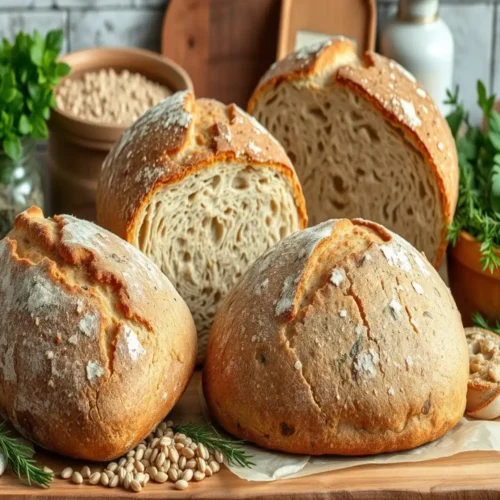
Organic Sourdough Bread: The Healthiest Bread Recipe You’ll Love
A traditional organic sourdough bread recipe crafted with natural wild yeast and whole grain flours. Fermented for a rich flavor and packed with health benefits.
Equipment
- Mixing Bowl For combining ingredients.
- Wooden Spoon or Spatula For mixing the dough.
- Kitchen Scale For precise measurement of ingredients.
- Proofing Basket (Banneton) Optional, for shaping and proofing dough.
- Dutch Oven For baking to create a crispy crust.
- Measuring Cups/Spoons For measuring smaller quantities.
- Clean Towel For covering the dough during proofing.
- Bench Scraper Optional, for handling and shaping dough.
- Baking Sheet or Parchment Paper Optional, for alternative baking methods.
Ingredients
- 500 grams Bread Flour Organic, unbleached
- 100 grams Whole Grain Flour Optional, adds flavor and nutrition
- 300 ml water Room temperature
- 100 grams Sourdough Starter Active and bubbly
- 10 grams salt Fine sea salt preferred
Instructions
- Prepare the StarterFeed your sourdough starter 6–8 hours before you plan to bake to ensure it is active and bubbly.
- Mix the DoughIn a large bowl, combine 500 grams of bread flour, 100 grams of whole grain flour, and 350 ml of water. Mix until just combined. Cover with a clean towel and let it rest for 30 minutes (autolyse).
- Add the Salt and StarterAdd 10 grams of salt and 100 grams of active sourdough starter to the dough. Mix thoroughly using your hands or a spatula until the ingredients are well incorporated.
- Bulk FermentationLet the dough ferment at room temperature (about 70°F/21°C) for 4–6 hours. During this time, perform 3–4 sets of stretch-and-folds every 30 minutes to build gluten strength.
- Shape the DoughAfter bulk fermentation, gently turn the dough out onto a floured surface. Shape it into a round or oval loaf and place it seam-side up in a floured proofing basket (banneton).
- Proof the DoughCover the dough and let it proof at room temperature for 2–4 hours, or refrigerate it overnight for a slower fermentation and enhanced flavor.
- Preheat the OvenPreheat your oven to 475°F (245°C) with a Dutch oven inside for at least 30 minutes.
- Bake the BreadCarefully transfer the dough to the hot Dutch oven. Score the top with a sharp blade or lame. Cover with the lid and bake for 20 minutes. Remove the lid and bake for another 20–25 minutes until the crust is deep golden brown.
- Cool the BreadRemove the bread from the oven and let it cool on a wire rack for at least 1 hour before slicing.
Notes
-
Flour Substitutions: You can use a mix of bread flour, whole wheat flour, or even ancient grains like spelt or einkorn for added flavor and nutrition. Adjust water slightly if using whole grain flours.
-
Fermentation Time: For a stronger sour flavor, extend the fermentation or proofing time. Refrigerating overnight develops more complex flavors.
-
Baking Equipment: If you don’t have a Dutch oven, use a baking stone or sheet, and add a pan of water to the oven for steam.
-
Troubleshooting: If your bread doesn’t rise well, ensure your sourdough starter is active and bubbly before use.
-
Storage: Store in a paper bag or bread box at room temperature for up to 3 days. For longer storage, slice and freeze the bread for up to 3 months.
Enjoy your homemade sourdough with butter, jam, or your favorite spreads!